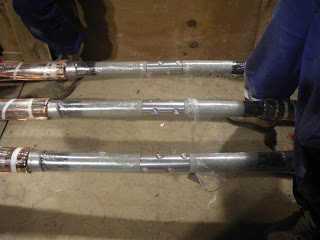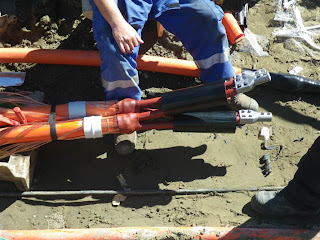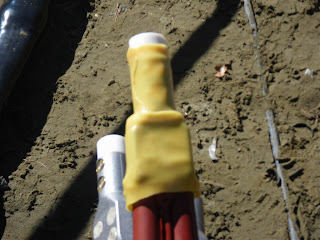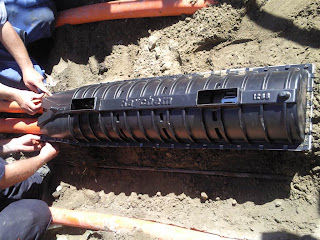Week 9 - Pump station, Timara 'loop joint', Fitzgerald Ave 66kV, base of Clifton hill.
This is an account of my last week in Cable Jointing. Next week: Line Mechanic work!
Work log:
Monday 28th March: 11kV XLPE-XLPE-XLPE supply to pump station by estuary, joint from September quake torn apart by February quake.
Tuesday 29th March: Corner Rothesay Road and Putake Drive, Timara Park. 11kV XLPE-XLPE and XLPE 'loop joint' (see analysis).
Wednesday 30th March: Fitzgerald Avenue 66kV XLPE-XLPE joint of 3 x 50 Megawatt cables (see analysis).
Thursday 31st March: Fitzgerald Avenue 66kV again.
Friday 1st April: Clifton Hill by Shag Rock (now Shag Pile!) 11kV PILCA-XLPE-PILCA.
Analysis:
Work log:
Monday 28th March: 11kV XLPE-XLPE-XLPE supply to pump station by estuary, joint from September quake torn apart by February quake.
 |
| 'Torn apart' joint. |
Tuesday 29th March: Corner Rothesay Road and Putake Drive, Timara Park. 11kV XLPE-XLPE and XLPE 'loop joint' (see analysis).
 |
| 'Loop joint'. |
Wednesday 30th March: Fitzgerald Avenue 66kV XLPE-XLPE joint of 3 x 50 Megawatt cables (see analysis).
 |
| The 3x 66kV XLPE joints done up. |
Friday 1st April: Clifton Hill by Shag Rock (now Shag Pile!) 11kV PILCA-XLPE-PILCA.
 |
| Under Clifton Hill.. 'run for the beach if the ground shakes'!! |
 |
| 'Shag Pile', the rock formerly known as Shag Rock! |
Analysis:
Heatshrink vs cold shrink
After several 'discussions' with colleagues, I decided to really investigate this subject, with experts and my own research, as it appears to be controversial! I have found that those who actively use each type of shrink find it most useful to them, and think everyone else should be using the shrink they use!
So here it is; Andrew's unbiased observation of the Heatshrink vs. Coldshrink war!
Coldshrink pros:
Doesn't need heat or an open flame to shrink down, so can be used in hazardous situations.
Easy to use with regard to the shrinking process.
Coldshrink cons:
Can only be used on XLPE cable (unverified).
Has a 'shelf life' it must be used within.
Is weaker than heatshrink.
Using requires more accurate measurement than heatshrink.
Doesn't shrink down as much as heatshrink, so less room to use when installing before shrinking.
More expensive than heatshrink (but getting cheaper).
Impact protection not as good as heatshrink.
Heatshrink pros:
Copes better with bending stress and pressure.
Mechanically more robust.
Can be used with more cable types than coldshrink.
Is a time-proven technology.
Cheaper than coldshrink.
Flexibility in accuracy.
Heatshrink cons:
CANNOT be used in an explosive environment due to heat needed.
I can imagine some interesting comments following this wee analysis!
66,000 volt underground cable jointing
I had the rare privilege to observe the repair of one break in the 3x 66,000 volt XLPE 1600mm2 cables that run between Armagh Substation (an inside substation next to Orion head office) and Lancaster Substation. This repair demanded the skills of some of the best cable jointers in the country. The experts from Tyco (who sell the joint kits) were employed to do the jointing, as well as one of the best Connetics jointers.
Joining the cables is an exercise in precision engineering, with super-accurate measurements being required, and an especially high level of care and cleanliness. They generously allowed me to 'do up' some shearbolts on one termination, which resulted in a small amount of panic as I nearly damaged the XLPE insulation (but I didn't!)
Specialised and heavy-duty tools are used, along with the work being done inside a purpose-built marquee-type structure to keep external dust and weather out. A security guard is posted all night also.
I was told the cables were capable of transmitting 50 Megawatts (MW) of power each.
The 'loop joint'
This joint is so called because it joins two underground cables that come from the same direction. It uses a special type of shearbolt as a consequence, and an underground encasing container, known ominously as a 'coffin'!
The loop joint seen here was installed at the corner of Rothesay Road and Putake Drive, in Timara Park, Burwood. It was done on two 11kV XLPE cables as part of Orions' network consolidation plan.
Finally, a couple of queries I need to address;
1) How will I introduce the specific use of these tools to my students?
Practical demonstration of the applications for the tools would be the most effective way to illustrate the use of the tools. The students will most likely have seen these tools in use already on the job, but the demonstration will involve safe and effective use of the tools also. I have videos of these tools in use that I can put on a moodle website also.
2) Attributes of cable jointers - how will I provide a sense of the camaderie of the cable joiners community of practice and sense of professional identity to my students?
In practical exercises, students could be set tasks in groups of two or four, depending on the task. This will instil an attitude of teamwork in the students, and also give them a sense of what the 'real world' will feel like.
This can be linked to Vygotsky's 'zone of proximal development' theory, where students belong to a community, or team, play their part in that team to obtain the meaning of the exercise, practice the exercise, and when completed successfully, gain a sense of identity that they belong in the team that completed the exercise undertaken. This will inspire confidence for the students when they attempt practical assessment.
Also the interaction amongst the team (particularly when problem solving) links up with George Siemens' Connectivism theory, where students will interact to obtain viable solutions for a common problem, and accept or reject ideas from peers in the team to make decisions on the task at hand.
And lastly, once on-job, the students will be moulded into the team environment by the team. If the individual does not become part of the team, both themselves and the team will be affected and performance will reduce until something 'gives'. The advantage in this situation is the student (trainee) demographic shows them to be younger and more flexible. Good leadership by experienced team members is particularly helpful during the trainees' learning stage.
And that's it! Next week: Line Mechanic!
So here it is; Andrew's unbiased observation of the Heatshrink vs. Coldshrink war!
Coldshrink pros:
Doesn't need heat or an open flame to shrink down, so can be used in hazardous situations.
Easy to use with regard to the shrinking process.
Coldshrink cons:
Can only be used on XLPE cable (unverified).
Has a 'shelf life' it must be used within.
Is weaker than heatshrink.
Using requires more accurate measurement than heatshrink.
Doesn't shrink down as much as heatshrink, so less room to use when installing before shrinking.
More expensive than heatshrink (but getting cheaper).
Impact protection not as good as heatshrink.
Heatshrink pros:
Copes better with bending stress and pressure.
Mechanically more robust.
Can be used with more cable types than coldshrink.
Is a time-proven technology.
Cheaper than coldshrink.
Flexibility in accuracy.
Heatshrink cons:
CANNOT be used in an explosive environment due to heat needed.
I can imagine some interesting comments following this wee analysis!
66,000 volt underground cable jointing
I had the rare privilege to observe the repair of one break in the 3x 66,000 volt XLPE 1600mm2 cables that run between Armagh Substation (an inside substation next to Orion head office) and Lancaster Substation. This repair demanded the skills of some of the best cable jointers in the country. The experts from Tyco (who sell the joint kits) were employed to do the jointing, as well as one of the best Connetics jointers.
Joining the cables is an exercise in precision engineering, with super-accurate measurements being required, and an especially high level of care and cleanliness. They generously allowed me to 'do up' some shearbolts on one termination, which resulted in a small amount of panic as I nearly damaged the XLPE insulation (but I didn't!)
Specialised and heavy-duty tools are used, along with the work being done inside a purpose-built marquee-type structure to keep external dust and weather out. A security guard is posted all night also.
I was told the cables were capable of transmitting 50 Megawatts (MW) of power each.
 |
| The worksite on Fitzgerald Ave |
 |
| The faulty section of the cable has already been removed and the concrete it was encased in removed also. Extra lengths of 66kV cable are used to replace the faulty sections. |
 |
| Ends cut off to the right length |
 |
| Specialised tool for removing the semiconductor layer. |
 |
| Sanding the rest of the semiconductor layer off. Finer and finer paper is used until the XLPE has a clean shiny finish. |
 |
| Coarse sanding |
 |
| The scale of a single 66kV cable |
 |
| The concrete the original cable is encased in |
 |
| Packaged up shearbolt |
 |
| The same stripping tool is used to remove the XLPE insulation layer. |
 |
| Measurements are made |
 |
| Conductor is exposed |
 |
| Shearbolts attached |
 |
| Close up of shearbolts |
 |
| Shearing bolts off |
 |
| Shearbolts sheared off - terminals complete |
 |
| Lighting in the night |
 |
| Layers of insulation installed |
 |
| Shrinking down the heatshrink |
 |
| Shrink 'shrunk'! |
 |
| 3x completed joints |
 |
| Heavy-duty cutter for big cables |
 |
| Close up of a cross-section of the cable |
The 'loop joint'
This joint is so called because it joins two underground cables that come from the same direction. It uses a special type of shearbolt as a consequence, and an underground encasing container, known ominously as a 'coffin'!
The loop joint seen here was installed at the corner of Rothesay Road and Putake Drive, in Timara Park, Burwood. It was done on two 11kV XLPE cables as part of Orions' network consolidation plan.
 |
| The terminal block |
 |
| Blocks in place. Note the cables lying together. |
 |
| The shearbolt. Multiple shear points are apparent. The uppermost one that has no thread engaged will shear. |
 |
| Bolts in place |
 |
| Shearing using the 'rattlegun' |
 |
| Cables snugly trapped |
 |
| A plug at the opposite end is attached using more shearbolts |
 |
| Insulation is applied |
 |
| Heatshrink shrunk on |
 |
| 3x completed joints |
 |
| Attached snugly together |
 |
| Earth cage installed |
 |
| Laid in 'coffin' |
 |
| Coffin lid attached |
 |
| Jamie filling coffin with a bichemical resin |
 |
| Still filling |
 |
| Installing lids |
 |
| The finished product; the 'coffin' gets extremely warm when the resin chemical is hardening |
 |
| Finished |
Finally, a couple of queries I need to address;
1) How will I introduce the specific use of these tools to my students?
Practical demonstration of the applications for the tools would be the most effective way to illustrate the use of the tools. The students will most likely have seen these tools in use already on the job, but the demonstration will involve safe and effective use of the tools also. I have videos of these tools in use that I can put on a moodle website also.
2) Attributes of cable jointers - how will I provide a sense of the camaderie of the cable joiners community of practice and sense of professional identity to my students?
In practical exercises, students could be set tasks in groups of two or four, depending on the task. This will instil an attitude of teamwork in the students, and also give them a sense of what the 'real world' will feel like.
'Team building' exercises that have nothing to do with jointing could be an idea, also, to give the students an idea of the flexibility required to perform a team task with a common goal where they are all on a 'level playing field' as far as skills and experience go.
This can be linked to Vygotsky's 'zone of proximal development' theory, where students belong to a community, or team, play their part in that team to obtain the meaning of the exercise, practice the exercise, and when completed successfully, gain a sense of identity that they belong in the team that completed the exercise undertaken. This will inspire confidence for the students when they attempt practical assessment.
Also the interaction amongst the team (particularly when problem solving) links up with George Siemens' Connectivism theory, where students will interact to obtain viable solutions for a common problem, and accept or reject ideas from peers in the team to make decisions on the task at hand.
And lastly, once on-job, the students will be moulded into the team environment by the team. If the individual does not become part of the team, both themselves and the team will be affected and performance will reduce until something 'gives'. The advantage in this situation is the student (trainee) demographic shows them to be younger and more flexible. Good leadership by experienced team members is particularly helpful during the trainees' learning stage.
And that's it! Next week: Line Mechanic!



Comments
good layout on the photos :) I got a good sense of the process although I had no clue on the various acronyms and technical jargon :(
It will be good to explore how to introduce novices to the electrician's 'glossary' of terms and to sieve out which terms are most important to know before students go out on their first work attachment.
Keep up with the high blogging standard. Selena